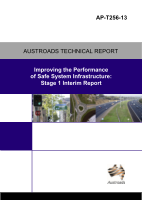Road Safety

Improving the Performance of Safe System Infrastructure: Stage 1 Interim Report
- Publication no: AP-T256-13
- ISBN: 978-1-925037-33-3
- Published: 27 November 2013
- PDF (free) Download
This report summarises the findings from the first year of a three-year study which reviews the safety performance of road infrastructure elements identified as Safe System solutions. The first stage sought to identify these solutions and to establish how closely they fit the vision’s objectives. Following stakeholder input, the study focussed on investigations of traffic signals, roundabouts, median flexible barriers (divided and undivided roads), and roadside flexible barrier applications.
In further stages, the project is to identify areas of improvement for the selection, application and management of these solutions, so that their safety performance is brought closer to the Safe System vision.
- 1. Introduction
- 1.1. Background
- 1.2. Project Aim and Scope
- 2. Methodology
- 2.1. Project Stakeholder Consultation
- 2.2. Literature Review
- 2.3. Crash Data Analysis
- Traffic signals and roundabouts
- Flexible barriers
- 3. Safe System Infrastructure
- 3.1. Safe System Vision and Objectives
- 3.2. Safe Systems Infrastructure Solutions
- 3.2.1. Policy Background
- 3.2.2. Research Background
- 3.2.3. Considerations in Safe System Infrastructure
- 3.3. Project Focus
- 4. Findings
- 4.1. Traffic Signals
- 4.1.1. Literature Review
- 4.1.2. Crash Data Analysis
- 4.2. Roundabouts
- 4.2.1. Literature Review
- 4.2.2. Crash Data Analysis
- 4.3. Flexible Barriers
- 4.3.1. Flexible Median Barriers on Divided Roads
- 4.3.2. Flexible Median Barriers on Undivided Rural Roads
- 4.3.3. Flexible Roadside Barriers
- 4.3.4. Crash Data Analysis
- 5. Summary
- 5.1. Traffic Signals
- 5.2. Roundabouts
- 5.3. Flexible Barriers (All Applications)
- 6. Next Steps
- References
- Appendix A Literature Review
- A.1 Introduction
- A.2 Traffic Signals
- A.2.1 Treatment Description
- A.2.2 General Safety Effects of Traffic Signals
- A.2.3 Safety Effect of the Number of Intersection Legs
- A.2.4 Safety Effects of Right-turn Control Phases
- A.2.5 Safety Effects of Channelisation
- A.2.6 Summary
- A.3 Roundabouts
- A.3.1 Treatment Description and Subtypes
- A.3.2 General Safety Effects of Roundabouts
- A.3.3 Safety Effects by Road User Type
- A.3.4 Safety Effects by Roundabout Type
- A.3.5 Summary
- A.4 Flexible Median Barriers (Divided Roads)
- A.4.1 Treatment Description
- A.4.2 Safety Effectiveness
- A.4.3 Summary
- A.5 Flexible Barriers in Painted Medians (Undivided Rural Roads)
- A.5.1 Treatment Description
- A.5.2 Safety Effectiveness
- A.5.3 Discussion
- A.5.4 Summary
- A.6 Flexible Roadside Barriers
- A.6.1 Treatment Description
- A.6.2 Safety Effectiveness
- A.6.3 Summary
- Appendix B Data Analysis
- B.1 Introduction
- B.2 Methods
- B.2.1 Traffic Signals and Roundabouts
- B.2.2 Flexible Barriers
- B.3 Relative Risk of Severe Crashes
- B.4 Traffic Signals
- B.4.1 Crash Severity at Signalised Intersections
- B.4.2 Severe Crash Incidents at Signalised Intersections
- B.4.3 Vulnerable Road Users
- B.4.4 Pedestrians
- B.4.5 Cyclists
- B.4.6 Motorcyclists
- B.4.7 Discussion and Conclusions
- B.5 Roundabouts
- B.5.1 Crash Severity at Roundabouts
- B.5.2 Severe Crash Incidents at Roundabouts
- B.5.3 Vulnerable Road Users
- B.5.4 Pedestrians
- B.5.5 Cyclists
- B.5.6 Motorcyclists
- B.5.7 Discussion and Conclusions
- B.6 Flexible Barriers
- B.7 Discussion and Conclusions
Related publications
WEB-ZRT-24
Latest Road Safety News
